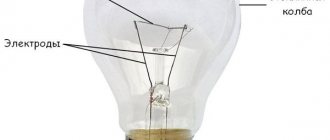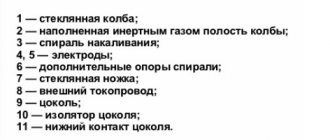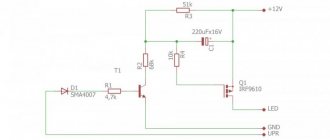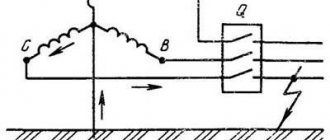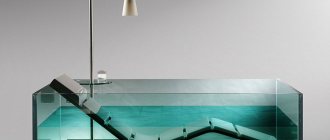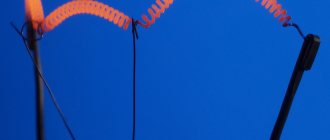The modern lighting market today is represented not only by a variety of lamps, but also by light sources. Some of the oldest light bulbs of our time are incandescent lamps (ILVs).
Even taking into account the fact that today there are more advanced light sources, incandescent lamps are still widely used by people to illuminate various types of rooms. Here we will consider such an important parameter of these lamps as heating temperature during operation, as well as color temperature.
Features of the light source
Incandescent lamps are the very first source of electric light that was invented by man. These products can have different power (from 5 to 200 W). But the most commonly used models are 60 W.
Note! The biggest disadvantage of incandescent lamps is their high electricity consumption. Because of this, the number of LNs that are actively used as a light source decreases every year.
Before you begin to consider parameters such as heating temperature and color temperature, you need to understand the design features of such lamps, as well as the principle of its operation. An incandescent lamp, during its operation, converts electrical energy passing through a tungsten filament (spiral) into light and heat. Today, radiation, according to its physical characteristics, is divided into two types:
Incandescent lamp device
- thermal;
- luminescent.
By thermal, which is typical for incandescent lamps, we mean light radiation. The glow of an incandescent light bulb is based on thermal radiation. Incandescent lamps consist of:
- glass flask;
- refractory tungsten filament (part of the spiral). An important element of the entire lamp, since if the filament is damaged, the light bulb stops glowing;
- base
During the operation of such lamps, the t0 of the filament increases due to the passage of electrical energy in the form of current through it. To avoid rapid burnout of the filament in the spiral, air is pumped out of the flask. Note! In more advanced models of incandescent lamps, which are halogen bulbs, instead of a vacuum, an inert gas is pumped into the bulb. The tungsten filament is installed in a spiral, which is fixed to the electrodes. In a spiral, the thread is in the middle. The electrodes to which the spiral and tungsten filament are installed, respectively, are soldered to different elements: one to the metal sleeve of the base, and the second to the metal contact plate. As a result of this design of the electric light bulb, the current passing through the spiral causes heating (an increase in t0 inside the bulb) of the filament, as it overcomes its resistance.
Kinds
Today there are a large number of different lamps, which are divided according to the shape and coating of the bulb, purpose and filler. It can be spherical, cylindrical, tubular and spherical; transparent, mirror and matte. There are also light sources for general, local and quartz-halogen purposes. In addition, there are vacuum, argon, xenon, krypton and halogen models.
Transparent ones are common options. Such elements are considered the cheapest and most effective; they have an uneven light flow. Mirror models are the most effective in terms of lighting, since the coating generates directional light flow. Matte ones are able to create soft and diffuse lighting for favorable working and leisure conditions. Products with local lighting operate at twelve volts, which is necessary to create safe working conditions.
Note! Such lamps are needed to illuminate inspection holes during the installation of electrical garage wiring.
Incandescent lamp types table
General purpose lamps
General-purpose sources are the most common light sources that are used to illuminate an apartment or factory on a network with an alternating current of 220 volts and a frequency of up to 50 hertz. There are vacuum, argon and krypton. The same group is neodymium and krypton. Essentially these are ordinary lighting lamps. It is worth pointing out that at the time of manufacturing neodymium sources, neodymium oxide is used, which absorbs the light spectrum. This improves the light quality.
You might be interested in: Features of street lighting
Widespread use of general purpose luminaires
Spotlight lamps
Spotlight sources are installed on ship, railway, theater and other searchlights. They differ in that they have an increased light output and can be supplemented with reflectors to improve the concentration of the light beam.
Spotlights as one of the types
Mirror lamps
Mirror light sources are distinguished by the fact that they have the usual bulb shape and a special internal coating of the bulb part. This helps to collect all the light flow, which is directed in the right direction. They are used in industry, videography, farming and bathroom ceiling lighting.
Halogen lamps
Halogen lamps are powered by an inert gas, to which bromine and iodine are added to protect the filament and increase operating life. Such light sources are small in size for use as a filler of expensive inert gas. They are distinguished by their brightness, natural color rendering, good service life and significant luminous efficiency, having smaller dimensions.
Note! The only negative is the sensitivity and significant changes in mains voltage.
Halogen lamps as one of the types
Working principle of a light bulb
Working incandescent lamp
Heating of the LN during operation occurs due to the design features of the light source. It is precisely because of the strong heating during operation that the operating time of the lamps is significantly reduced, which makes them not so profitable today. In this case, due to heating of the filament, t0 of the flask itself increases.
The operating principle of the LN is based on the conversion of electrical energy that passes through the spiral threads into light radiation. In this case, the temperature of the heated thread can reach 2600-3000 oC.
Note! The melting point for tungsten, from which the spiral threads are made, is 3200-3400 °C. As we can see, normally the heating temperature of the filament cannot lead to the beginning of the melting process.
The spectrum of lamps with this structure differs markedly from the spectrum of daylight. For such a lamp, the spectrum of emitted light will be characterized by a predominance of red and yellow rays. It is worth noting that the flasks of more modern LN (halogen) models are not evacuated, and also do not contain a spiral thread. Instead, inert gases (argon, nitrogen, krypton, xenon and argon) are pumped into the flask. Such design improvements led to the fact that the heating temperature of the flask during operation decreased somewhat.
The operating principle of an electric incandescent lamp
Having considered what a light bulb consists of, it is important to understand the principle of its operation:
- When the light is turned on, current flows through the bottom of the base to the filament body.
- The tungsten filament becomes very hot after closing the electrical circuit, which causes it to glow.
- At this point, the thread temperature reaches 570 degrees.
- Thus, the light spectrum of the light bulbs is shifted towards warm temperatures.
For reference: the lower the degree of tungsten/carbon filament, the lower will be the proportion of energy that approaches the filament body and provokes its visible radiation. Retro lamps are different in that they heat up the coil more slowly and weakly.
Advantages and disadvantages of the light source
Despite the fact that today the light source market is replete with a wide variety of models, incandescent lamps are still quite common on it. Here you can find products for different amounts of W (from 5 to 200 W and above). The most popular light bulbs are from 20 to 60 W, as well as 100 W.
Range of choice
LN continue to be used quite widely because they have their own advantages:
- when turned on, the light ignites almost instantly;
- small dimensions;
- low cost;
- models with only vacuum inside the flask are environmentally friendly products.
It is precisely these advantages that determine the fact that LNs are still quite in demand in the modern world. In homes and workplaces today you can easily find representatives of these lighting products rated at 60 W and higher. Note! A large percentage of LN use relates to industry. Often powerful models (200 W) are used here. But incandescent lamps also have a fairly impressive list of disadvantages, which include:
- the presence of blinding brightness of light emanating from lamps during operation. As a result, the use of special protective screens is required;
- During operation, heating of the filament, as well as the flask itself, is observed. Due to the strong heating of the flask, if even a small amount of water gets on its surface, an explosion is possible. Moreover, heating of the bulb occurs for all light bulbs (at least 60 W, at least lower or higher);
Note! Increasing the heating of the flask still carries a certain degree of danger of injury. The increased temperature of the glass flask, when touched with unprotected skin, can cause a burn. Therefore, such lamps should not be placed in lamps that a child can easily reach. In addition, damage to the glass bulb can cause cuts or other injuries.
Tungsten filament glow
Important Evaluation Parameters
One of the most important parameters of LN operation is the light coefficient. This parameter has the form of the ratio of the radiation power of the visible spectrum and the power of consumed electricity. For this product this is a fairly small value, which does not exceed 4%. That is, LN is characterized by low light output. Other important operating parameters include:
- light flow;
- color t0 or glow color;
- power;
- life time.
Let's consider the first two parameters, since we figured out the service life in the previous paragraph.
Light flow
Luminous flux is a physical quantity that determines the amount of luminous power in a particular stream of light emission. In addition, there is another important aspect, such as light output. It determines for a lamp the ratio of the luminous flux emitted by the lamp to the power it consumes. Luminous output is measured in lm/W.
Note! Luminous efficiency is an indicator of the economy and efficiency of light sources.
Table of luminous flux and luminous efficiency of incandescent lamps
As you can see, for our light source the above values are at a low level, which indicates their low efficiency.
Results.
Incandescent lamps served people faithfully throughout the 20th century. In the current century, LED and fluorescent lighting devices are replacing them. In our country, as part of the fight for energy efficiency, programs have been adopted that stimulate the development of the production of more modern light sources. Many Russians have already stopped using incandescent lamps in their apartments. However, some of their advantages are unique. For example, high color rendering is indispensable for photo and film production. Many special lighting devices still work only using old technology. Some people simply take care of their eyes and use Ilyich’s lamp. And for rooms with short-term light switching on once a week, an incandescent lamp is the most economically feasible option. The choice remains with the individual consumer!
- Related Posts
- Which lamp to choose for plants - the best options
- What are fluorescent fluorescent lamps and what are they?
- How to determine LED polarity
Light bulb color
Color temperature (t0) is also an important indicator. Color t0 is a characteristic of the intensity of light emitted by a light bulb and is a function of the wavelength defined for the optical range. This parameter is measured in kelvins (K).
Color temperature for incandescent lamp
It is worth noting that the color temperature for LN is approximately 2700 K (for light sources with a power of 5 to 60 W and above). Color t0 LN is in the red and thermal tint region of the visible spectrum. Color t0 fully corresponds to the degree of heating of the tungsten filament, which prevents the FL from quickly failing.
Note! For other light sources (such as LED light bulbs), color temperature does not reflect how warm they are. With an LN heating parameter of 2700 K, the LED will warm up by only 80ºC.
Thus, the greater the power of the LN (from 5 to 60 W and higher), the greater the heating of the tungsten filament and the bulb itself will occur. Accordingly, the greater the color t0 will be. Below is a table where you can compare the efficiency and power consumption of different types of light bulbs. The control group with which comparison is being made here includes LNs with a power of 20 to 60 and up to 200 W.
Comparative table of powers of different light sources
As you can see, incandescent lamps in this parameter are significantly inferior to other light sources in terms of power consumption.
Properties and technical characteristics of resistors
As already noted, resistors in electrical circuits and circuits perform a regulatory function. For this purpose, Ohm's law is used, expressed by the formula: I = U/R. Thus, with a decrease in resistance, a noticeable increase in current occurs. And, conversely, the higher the resistance, the lower the current. Due to this property, resistors are widely used in electrical engineering. On this basis, current dividers are created that are used in the designs of electrical devices.
In addition to the current regulation function, resistors are used in voltage divider circuits. In this case, Ohm's law will look slightly different: U = I x R. This means that as the resistance increases, the voltage increases. The entire operation of devices designed to divide voltage is based on this principle. For current dividers, a parallel connection of resistors is used, and for voltage dividers, a series connection is used.
In the diagrams, resistors are displayed in the form of a rectangle measuring 10x4 mm. The symbol R is used for designation, which can be supplemented with the power value of a given element. For power above 2 W, the designation is made using Roman numerals. The corresponding inscription is placed on the diagram near the resistor icon. Power is also included in the markings on the element body. The units of resistance are ohm (1 ohm), kilohm (1000 ohm) and megaohm (1,000,000 ohm). The range of resistors ranges from fractions of an ohm to several hundred megaohms. Modern technologies make it possible to produce these elements with fairly accurate resistance values.
Read also: How to sharpen gel eyeliner
An important parameter of a resistor is the resistance deviation. It is measured as a percentage of the nominal value. The standard series of deviations is represented by values in the form: +20, +10, +5, +2, +1% and so on up to a value of +0.001%.
The power of the resistor is of great importance. An electric current passes through each of them during operation, causing heating. If the permissible power dissipation value exceeds the norm, this will lead to failure of the resistor. It should be taken into account that during the heating process the resistance of the element changes. Therefore, if devices operate over wide temperature ranges, a special value called the temperature coefficient of resistance is used.
To connect resistors in circuits, three different connection methods are used - parallel, series and mixed. Each method has individual qualities, which allows these elements to be used for a variety of purposes.
Lighting technology and glow color
In lighting technology, the most important parameter for a light source is its color t0. Thanks to it, you can determine the color tone and chromaticity of light sources.
Color Temperature Options
The color t0 of light bulbs is determined by the color tone and comes in three types:
- cold (from 5000 to 120000K);
- neutral (from 4000 to 50000K);
- warm (from 1850 to 20000K). It is given by a stearic suppository.
Note! When considering the color temperature of the LN, it should be remembered that it does not coincide with the real thermal temperature of the product, which is felt when you touch it with your hand.
For LN, the color temperature ranges from 2200 to 30000K. Therefore, they can have radiation close to ultraviolet.


